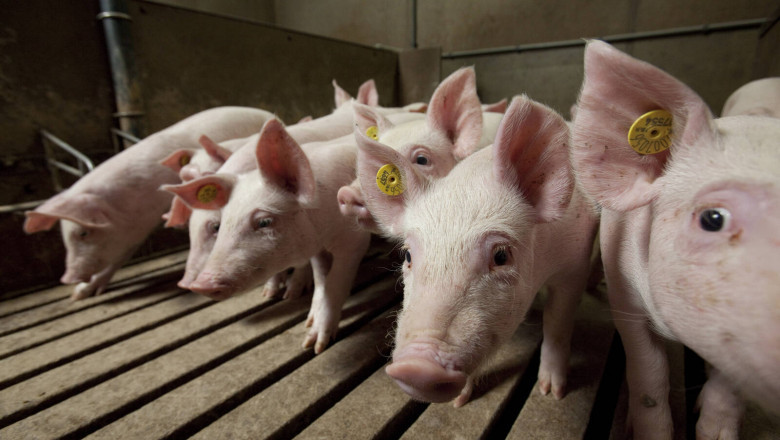views

Classification and function of amino acids in pig feed

Amino acids are indispensable nutrients for pigs, but many people do not know much about amino acids, let alone the classification of amino acids. Today, Xiaobian will introduce the classification and functions of amino acids in pig feed.
Adult livestock and poultry need eight amino acids to maintain life: lysine, methionine, tryptophan, valine, phenylalanine, leucine, isoleucine and threonine; growing livestock and poultry In order to ensure normal growth and development, in addition to the above-mentioned essential amino acids, histidine and arginine are needed; young animals and young birds also need glycine, cystine and tyrosine in addition to the above-mentioned.
①Lysine can improve the utilization rate of protein and meat quality in animals. The lysine content in bean cake, fish meal and bone meat meal is rich, if they are used in compound feed, they generally do not feel lysine deficiency. With corn (2433, -3.00, -0.12%), cottonseed cake, sesame oil cake, etc. as feed, the protein utilization rate is low. When feeding pigs, chickens, etc., an appropriate amount of lysine needs to be added. Add 0.2% to 0.3% lysine to barley and corn to increase the utilization rate of protein from 50% to 70% to 80%. More than 90% of lysine is produced by fermentation of molasses.
②Methionine food and feed fortifier can improve the quality of lean meat, increase egg production rate and milk production, and its dosage accounts for about 0.05% to 0.30% of the feed amount. The test results show that adding 0.5kg of methionine to the compound feed is equivalent to adding 25kg of fish meal. Methionine has been used for more than 20 years, and it has developed more rapidly in the past 10 years. The annual growth rate of world methionine production is 29%. In 1979, the total production of methionine in the world reached 150kt. France's production ranked first in the world, followed by the Federal Republic of Germany. The United States, the Soviet Union, Mexico, and Italy also scrambled to build new plants to expand their productivity.
The key to the development of methionine production lies in the production of raw materials acrolein and methyl mercaptan. The industrially synthesized methionine analog with hydroxyl group, 2-tert-butyl-4,4-hydroxyanisole (MHA), can replace methionine, and MHA absorbs the amino group to replace the hydroxyl group and converts it into methionine in animals. 1.2g MHA is equivalent to 1g methionine.
③ Tryptophan can participate in the renewal of plasma proteins, promote the role of riboflavin, and contribute to the synthesis of niacin and heme. When livestock and poultry lack tryptophan, growth stagnation, weight loss, and testicular atrophy of male animals occur. Due to the high production cost and poor economic benefit of tryptophan, the annual output of tryptophan in the world is only several hundred tons. It is mainly used as an artificial milk additive for piglets, and the addition amount is 0.02% to 0.05%; a small part is used in the diet of sows and laying hens. (
The addition of amino acids to feed has been widely adopted. Generally, the content of lysine and methionine in grain and soybean meal-based plant feeds is low, which cannot meet the needs of animals. Adding amino acids can greatly save protein consumption, reduce feeding costs, and improve animal production efficiency.
Adding amino acids can improve the quality of pork. Adding lysine to pig diets can improve meat quality and increase lean meat rate. Experiments have shown that adding lysine to animal diets can improve the efficiency of protein synthesis in animals, relatively reduce body fat content, increase the proportion of lean meat, and improve meat quality.
Adding amino acids can improve the digestive function of animals and reduce environmental pollution. Intensive feeding piglets have high crude protein content and are prone to digestive system diseases such as diarrhea. This not only causes feed waste, but also affects animal growth. Adopting methods such as reducing the protein level of animal diets and supplementing methionine, lysine and glutamic acid can effectively improve the digestive function of animals, reduce diseases, enhance the disease resistance of animals, and reduce fecal nitrogen at the same time. It can effectively improve the small environment of the pig house and reduce the pressure of manure treatment. Adding amino acids can reduce stress in pigs. Stress is due to changes in external environmental conditions, which make animals unsuitable, which will cause a sharp drop in feed intake and affect the yield and quality of animal products. Experiments have shown that adding tryptophan can prevent pigs from weaning and excessive stocking density and other stress phenomena such as tail biting.












